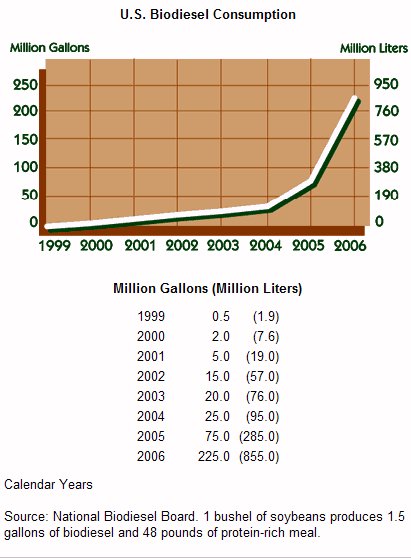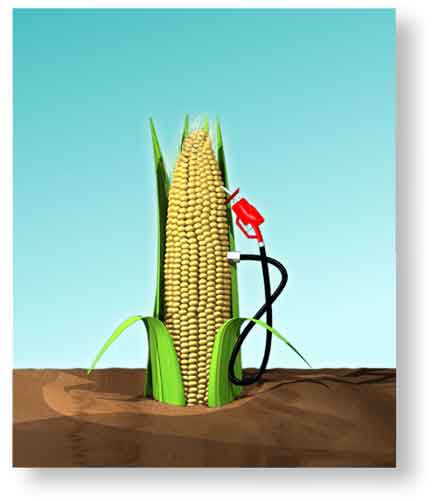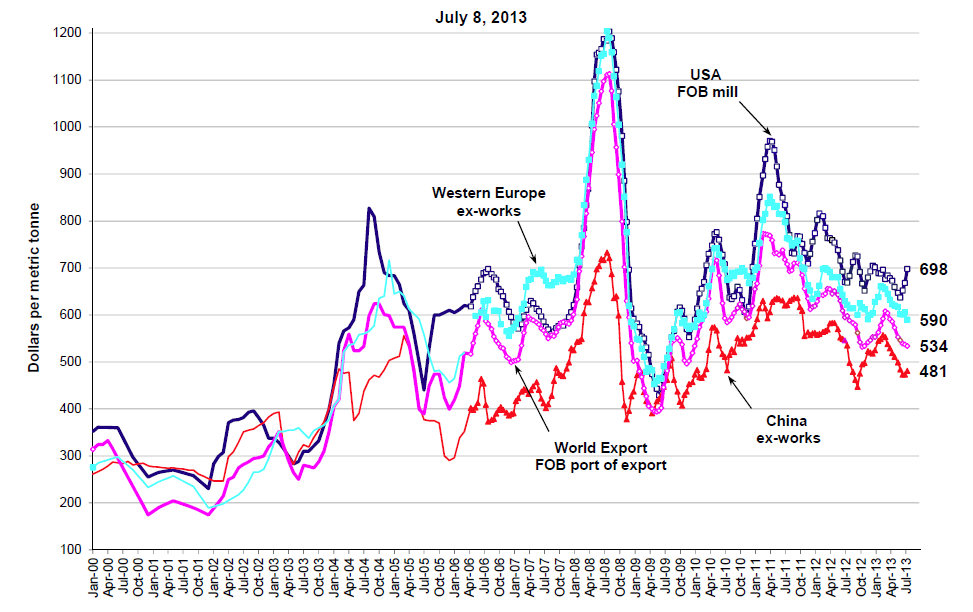|
|
|||||||||||||||||||||||||||||||
|
Green Gold - Is Biofuel the fuel of the future?
By Janet Ho - November 2007. The Simpsons is a long running cartoon show enjoyed by many for its satirical writing which poked fun at current issues. There was one episode in particular that aired January of this year where Lisa and Marge Simpson visited an Oceanic Institute and looked at a display case with a model of New York City in it. An electronic voice was heard saying, “Press the button to see the effects of global warming in the next three years”. When Lisa pressed the button, the display case quickly filled up with water flooding the city to the height of the Empire State Building and little figures of people floated up one by one face down on top the surface of the water. Marge then remarked matter of factly, “Well, three years is still a long time away”. As humourous as that Simpson’s scene was, it was only about five years ago that people still disputed the reality of global warming and the crisis of its rapid effects. At present, it has become a worldwide issue that has some countries racing to reduce carbon emissions and increase production of alternative energies. In 2005, the Canadian government invested $46 million dollars, on top of an already allocated $72 million, towards ethanol production. In the United States 225 million gallons of soy-based biodiesel was consumed last year. Biofuels have also become fashionable with endorsements from hybrid car advocates such as actor Cameron Diaz, and The Tonight Show host Jay Leno’s promotion of his biofuelled sports car. With this government and social support, it is apparent that biofuels are becoming the new environmental preference. However, this new trend is not without its fair share of controversy. Biofuels can be environmentally and socially hazardous rousing good green intentions from rest.
Biofuel is an alternative energy that can be produced from renewable resources and are meant to be a climate friendly substitute for fossil fuels. There are various types of biofuels but the most common that are being mass-produced are made from corn, sugarcane, soybean, and palm oil. At the moment, yellow corn is one of the largest sources of biofuel in North America. It is converted into ethanol and emits approx. 22% less greenhouse gases than gasoline when used as fuel. However the environmental costs associated with biofuel's production weigh much higher. In the October 2007 issue of National Geographic, Joel K. Bourne writes in the article Green Dreams that the process of making ethanol from corn is a “loser’s game, requiring more carbon-emitting fossil fuel than it displaces.” He states this because the process involves industrial farming methods such as the use of diesel machinery to drive the distillation process from corn to ethanol, and the fertilizer that is required to grow the corn emits nitrous oxide that is 300 times more insulating than the most common carbon dioxide. Some argue that the process of making corn based ethanol releases more green house gases than they save.
Moreover from a social position, the use of corn for fuel is causing the inflation of food prices. Earlier this year, thousands of Mexicans took the streets in a tortilla protest against the 400% rise in corn prices affected by increased demand for the product for alternative energy uses. In November 2007, the political analyst Noam Chomksy spoke at Toronto’s York University about the threat to the food staple for Mexican workers and the poor due to increase of corn production for the purpose of fuel. The Food and Agriculture Organization of the United Nations (FAO) reported that by 2015, the total number of undernourished people in developing countries would reach 582 million. It is numbers such as these that reason Chomsky to believe that “biofuels are likely to ‘starve the poor’ around the world…as staples are converted to ethanol production for the privileged”. Sugarcane is an alternative to corn as an ethanol based biofuel, however it is not in demand as a food source. Also, sugarcane yields 600 to 800 gallons an acre, twice as much as corn. And unlike corn which must be broken down into sugars with expensive enzymes before it can be fermented, the sugarcane stalk is already 20 percent sugar and starts to ferment as soon as it is cut. In Brazil, it is an agricultural staple and has been an alternative to fossil fuels for many years. Eighty five percent of cars sold in Brazil run on ethanol and it produces 56 % less green house gas emissions than gasoline. Though these environmental factors make this source a better alternative to corn, unfortunately the production of sugar cane ethanol is not without fault. Before cutting the sugarcane, the plants are often burned first for easier cutting. This process releases methane and nitrous oxide into the air. Also, the cutting of the sugarcane is done by hand and the work is backbreaking. There are reports of the exploitation of sugar cane workers and in some cases some workers have died from heat exhaustion. Furthermore, whether it is sugarcane or corn based, ethanol corrodes the traditional pipelines used to transport fuel, thus trucks are used to ship fuel releasing more carbon dioxide into the air.
Because bio-diesels such as soybean and palm are converted into fuel oil, they do not have the corroding components of ethanol. The advantage of soybean oil is that it can produce its own nitrogen when growing, as a result reducing the use of synthetic fertilizer and the greenhouse gases it emits. In addition, it produces 68 % less greenhouse emissions than gasoline. Unfortunately the production of soybean and palm biodiesel has caused vast deforestation. In Sumatra and Borneo, approximately 4 million hectares of forest have been converted to palm farms and in Malaysia, 6 million hectares are scheduled for clearance and 16.5 million in Indonesia. Many species of animals are at risk such as the Asian elephant and Sumutran tiger due to habitat loss and thousands of indigenous people have been evicted from their lands. It has been reported that around 500 Indonesians have been tortured when they tried to resist. In Argentina, the government of the north-western province of Salta stripped the Pizarro nature reserve of its legal status as a protected area in order to auction off part of the land to agribusiness firms. Like sugarcane, palm is easier to clear after set alight causing the threat of major forest fires and furthermore creating a blanket of carbon dioxide. It has been argued that palm oil is the worst of the biofuels due to its list of potential negative effects. Why biofuels then? Like its fossil fuel counterpart, biofuels are not as “green” conscious as people hope them to be. However, the move towards renewable energies is the first steps towards finding a better source. At the moment, research is ongoing to explore the advantages of cellulostic ethanol. Sources include forestry wastes such as wood chips and sawdust, household waste, and fast-growing prairie grasses which require less energy, less water, and can grow on marginal land. It is estimated that cellulostic ethanol would produce 91% less greenhouse gas emissions than gasoline.
Another alternative is in the study of algae. Compared to an acre of corn which produces 300 gallons of ethanol per year, each acre of algae can theoretically produce 5000 gallons. Algae not only reduces global warming gases but also devours other pollutants as well and can be converted into ethanol, biodiesel, or even jet fuel. At the moment algae research is still limited. In addition, it is unknown whether the production of cellulostic ethanol and algae fuels will result in higher fuel prices than gasoline, which is a significant factor in determining whether research will ever go beyond the labratories. The reality of biofuels will require further exploration. At present, the biofuel industry seems more monetarily centred than environmentally. As Homer Simpson once said, “Oh, used grease is worth money eh? Then my arteries are filled with yellow gold!”
Biofuels Not Environmentally FriendlyAccording to Nobel Prize winner Paul J. Crutzen biofuels actually contributes to global warming, because it is still the same basic result: Burnt fuel and carbon dioxide. But that is not all. Biofuels, which are derived from plants such as corn, hemp or canola, require producers to use industrial fertilizer which actually increase the output of nitrous oxide, a powerful greenhouse gas. Nitrous oxide is approx. 300 times more insulating than the most common man-made greenhouse gas carbon dioxide. "The nitrous oxide emission on its own can cancel out the overall benefit," says co-author Professor Keith Smith. Europe's biofuels are made mostly out of canola, which could produce between 1 and 1.7 times more greenhouse gases than diesel. In North American biofuels are made mostly out of corn was shown to produce between 0.9 and 1.5 times the greenhouse gases. In Brazil they use sugar cane and is one of the cleanest options, producing only between 0.5 and 0.9 times as much greenhouse gases as gasoline. The findings puts out the question: If burning biofuels still makes carbon dioxide and other greenhouse gases why use biofuels? However the study did not take into consideration “the extra global warming effect of burning fossil fuels in the process of making biofuel. Although Crutzen’s study seems to burn biofuels at the stake, the scientist suggests rather that scientists and farmers work in collaboration to focus on crops which would require little fertilization but grow fast, such as willows and poplars. The research team also suggests farmers look for harvesting methods that require less energy. "In future if you use low nitrogen demanding crops, and low impact agriculture, then we could get a benefit," said Professor Smith. Mass production of synthetic fertilizer during the 20th century has almost doubled the amount of nitrogen in the global system, adding nearly 100 million tonnes to atmosphere.
Biofuel isn't the Only Industry trying to Cash In on GreenerySo biofuel isn't really good for the environment. In fact it hurts the environment by basically setting fire to fields of crops in an effort to fuel cars. On the surface biofuel sounds green, but its just a deception to trick people into buying more expensive diesel. Another way to do this is in the cosmetics industry. If a company changes a few ingredients in one of their products and then slaps the words "Organic" or "Green" on the packaging they can charge more for a product than they normally would and make a bundle off the people willing to pay extra for a cosmetics product that uses something organic like beeswax instead of a synethetic material or man-made chemical. Or maybe doesn't even remove said chemicals, but just adds an organic component to the recipe. Organic skin care products for example often contain many such chemicals. All of which are designed to make your skin more silky smooth and moisturize your skin. Some of them, yes, are from organic sources. Aveeno Creamy Moisturing Oil for example contains Sesame Seed Oil, Oats Kernel Oil, Sweet Almond Oil... but it also contain glycerin, cetyl alcohol, glyceryl stearate, magnesium aluminum silicon and a host of other man made chemicals. So yes, the product contains various organic oils, but a bunch of other stuff too designed to moisturize your skin. Now how does using sesame seed oil help save the planet? Well... It doesn't. You're killing plants to give yourself softer skin. Its the same logic as biofuel. Oh look, its made from plants! Lets kill all the plants and use them for fuelling our cars and giving ourselves softer skin! Years ago there was an organization in China trying to convince people that everyone has to become vegetarian in order to somehow stop global warming and prevent "poisonous methane gases" from being released in the arctic. It was not only unrealistic (because people are not going to stop eating meat just to please the vegetarian community) but there is also the disconnect in the logic that eating plants instead will somehow prevent methane from being released in the arctic. Also, is organic food actually better for you? Well, according to scientists organic food doesn't make any difference in terms of pesticides or nutrition. Or at least not any major difference. The results of scientific studies show that organic food only has 30% less pesticides. Organic food is NOT pesticide free, because they are grown from genetically modified seeds to create their own pesticides to ward off insects. So you're either eating food that is sprayed with pesticides (and then washed off) or you are eating GMOD food that contains pesticides inside the plant. Yes, the amount of pesticides are 30% less than non-organic... but its really a minuscule difference. Say you have two grapes. 1 grape has 10 microns of pesticides on the surface. The other has 7 microns of pesticides inside it. And both are well below safety limits of something like 100 microns. So the question then is, is it worth it to pay double for genetically modified food that contains slightly less pesticides? And the same goes for skin care products. Why are you paying extra for a little something more on the label? Are you really saving the planet by using beeswax instead? No. If companies really want to go green what they should do is work on their PACKAGING first. Cut down on the amount of plastic they are using and use materials for packaging that can be more easily recycled. And while they are at it they should invest in building a fleet of transport trucks that run on hydrogen instead of diesel. Hydrogen is a way greener way of transporting things. And lastly, what about the products being shipped by air freight or via ship? Many organic food items are actually grown in South America and Africa and then shipped to North America in cargo planes. Cargo planes using jet fuel. Not very green at all. The food should be grown locally in greenhouses instead and reduce the cost of shipping dramatically. Many foods cannot be shipped in ocean liners because they will go bad by the time they reach port in North America. If consumers want to go green with their shopping they need to start thinking in terms of the following: #1. Buy Locally Made Products #2. Buy Products which use Minimal Packaging. #3. Read the Labels so you know what is in the product and how it was made. Organic or not organic, doesn't matter. Was the environment harmed during the process? Shop Smart!
Recycling Biofuel from Garbage OilI would argue that the only "good" kind of biofuel is that made from garbage oil from restaurants - they use the grease until it can be used no more and normally it would be thrown out - but there are companies that now specialize in recycling cooking oil and using it as biofuel. Recycling companies in general is a growing business. They take other people's junk - for a fee - and then recycle whatever they can and make more money off the recycled items. For them it is a double whammy, they get paid to remove garbage - and they get paid to deliver garbage to recycling centres. Everything from plastic, wood, metal, electronics and even bio-waste can be recycled. And even if it cannot be recycled, then it can be incinerated to produce electricity. So such companies have huge potential for profits. Take for example the junk removal Edmonton company Vanish Site Removal, which is a local company that provides residential and commercial rubbish collection and junk removal services in the Edmonton Area - and looking at their website, that appears to be their only services. According to their websites they do everything from standard household garbage pick-up to heavy junk hauling, not bad for a small company. But what they don't tell you is that they and other companies like them are taking the garbage they collect and then selling it to recycling centres. Their services are good and on par with other garbage removal Edmonton companies, so it doesn't really matter which company a person hires - they are all in the recycling business.
And very profitable. Lets take steel recycling for example. Steel prices are up dramatically since January 2000. By 2007 steel prices had doubled. In 2008 steel prices skyrocketed during the recesssion, making steel recycling extremely profitable. Currently (July 2013) prices are hovering around a little more than double January 2000 prices. Now to be fair, recycling steel was always a smarter route. It was cheaper than mining steel out of the ground. But now with steel prices sky high it means that recycling is ridiculously profitable. Therefore imagine the benefits of owning a company which collects junk - including steel - gets paid a fee just to collect it, and then recycles it for a huge profit. It is just brilliant. It makes me wonder if I am in the wrong business.
|
|
||||||||||||||||||||||||||||||
|
Website Design + SEO by designSEO.ca ~ Owned + Edited by Suzanne MacNevin | |||||||||||||||||||||||||||||||





